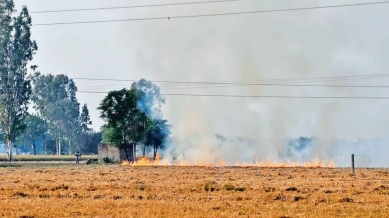Stay updated with the latest - Click here to follow us on Instagram
At nearly 2,000, farm fires in Punjab highest in a day; bad air continues in Delhi
Data from SAFAR shows that last year, daily peak contribution of stubble burning to PM 2.5 levels in Delhi was 34% on November 3, while it was 48% in 2021, 42% in 2020, and 44% in 2019.

With the harvest picking up pace, instances of stubble burning have been seeing a sharp rise in Punjab. On Wednesday, the state recorded 1,921 instances of burning — the highest single day count so far — up from 1,389 on Tuesday, and 1,030 on Monday.
Environment Minister Gopal Rai, who held a meeting on implementation of GRAP Stage II measures Wednesday, said if the AQI remains above 400 at hotspots in the city over the next one week, “then all construction work within a km radius of that hotspot can be directed to be stopped.”
According to the Decision Support System (DSS) developed by the Indian Institute of Tropical Meteorology, Pune, the contribution of biomass burning to PM 2.5 levels in Delhi on November 1 was 12.96%, up from 7.175% on Tuesday. The highest biomass burning contribution that the system has recorded so far this year is 23.48% on October 27.
Data from SAFAR shows that last year, daily peak contribution of stubble burning to PM 2.5 levels in Delhi was 34% on November 3, while it was 48% in 2021, 42% in 2020, and 44% in 2019.
In Haryana, the fire count on Wednesday was 99, up from 51 on Tuesday. This was the second highest single-day count in the state so far this year, after 127 on October 15.
The count, however, is lower than what it was in previous years in both states. Till November 1, Punjab recorded 9,594 instances of burning, lower than 17,846 over the same period in 2022, 15,065 in 2021, and 37,078 in 2020.
In Haryana, the cumulative count so far this year is 1,296, as against 2,083 in 2022, 3,038 in 2021, and 2,495 over the same period in 2020.
An IMD scientist said, “Over the next three-four days, the easterly, south-easterly component is likely to prevail when it comes to wind direction. Wind speed is set to remain low. At night, calm winds will prevail, with a low speed of 4 to 6 kmph during the day. Local pollutants are accumulating in the same place and not dispersing. Wind direction has mostly been easterly so far, which is why the impact of burning has not been as high.”
Northwesterly winds usually help carry smoke from crop residue burning to Delhi. “For the situation to improve, we either need rainfall, which has been elusive as there has been no active western disturbance. There is no likelihood of an improvement in wind speed in the next 3-4 days,” he added.
A forecast issued by the Air Quality Early Warning System on Wednesday said the air quality is likely to remain in the ‘very poor’ category from November 2 to 4, and for six days thereafter.